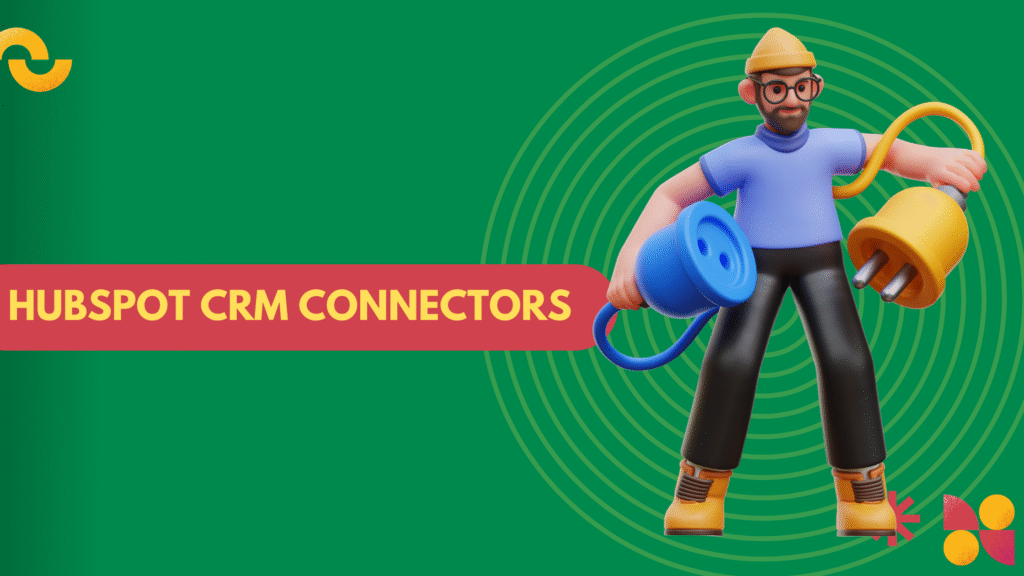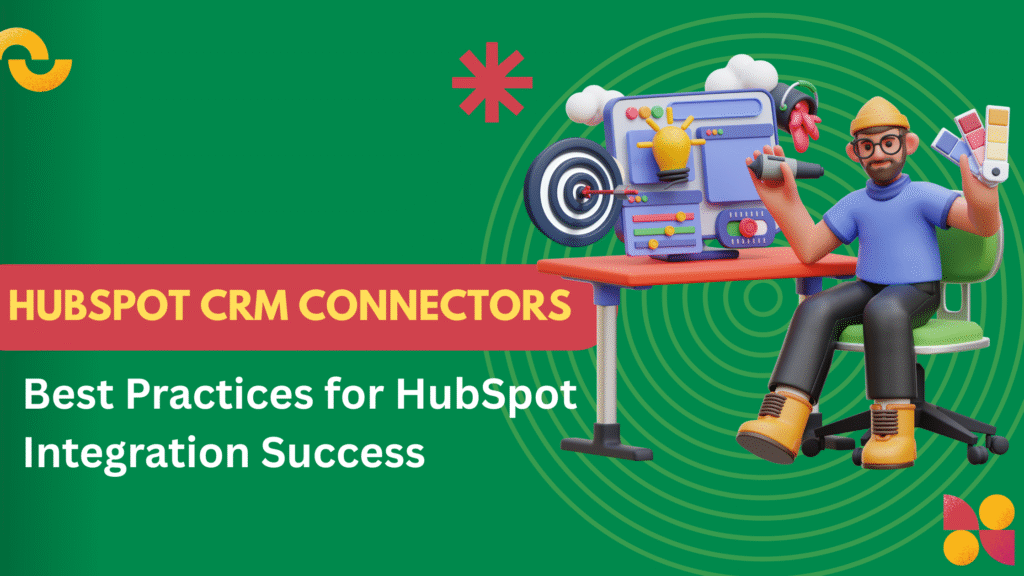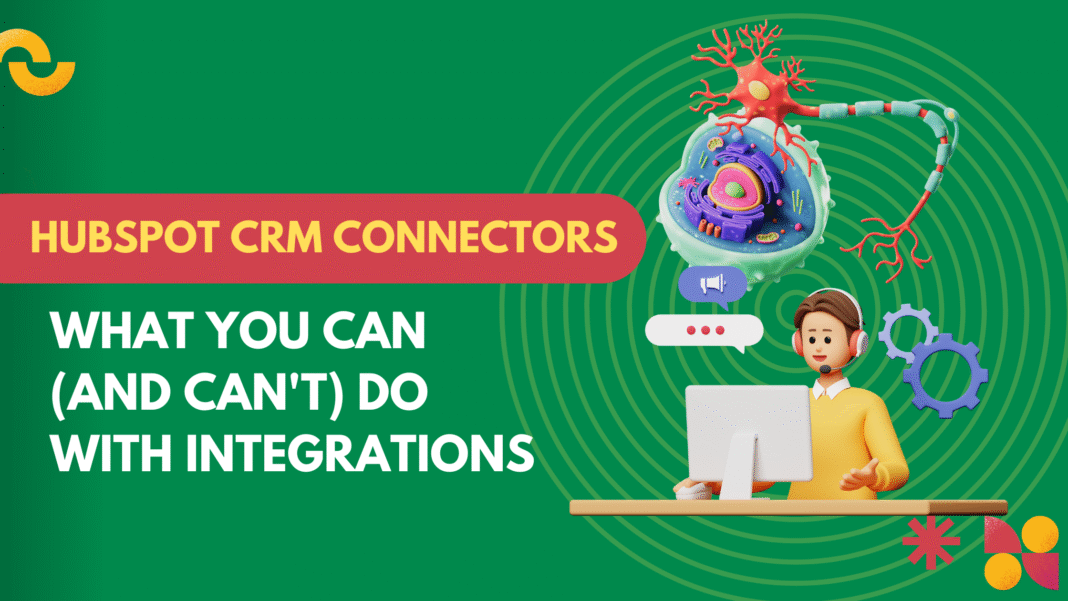HubSpot CRM connectors are designed to cut out repetitive data entry by linking the tools you already use.
Email, website forms, calendars, payments, and more—into one seamless system.
Instead of juggling platforms and retyping the same details, information syncs automatically so your sales and marketing never miss a beat.
I didn’t realize how powerful that could be until I set up my first few integrations. In the past, I wasted hours copying contact details into emails, invoices, and meeting calendars.
It was frustrating, and worse—it kept me from building relationships and closing deals.
The moment I connected HubSpot with my email, website forms, and payment system, everything changed.
Data flowed on its own, deals moved forward without friction, and my business finally felt like it was running in a higher gear. That’s the real value of HubSpot connectors: turning scattered tools into a smooth, automated workflow.
And with over 1,800 integrations available in HubSpot’s App Marketplace, most small and mid-sized businesses already have more than enough options at their fingertips. The real challenge isn’t access.
it’s knowing which integrations will actually help you and which might complicate your setup.
How HubSpot CRM Connectors Transform Your Daily Workflow

What Are HubSpot CRM Connectors?
HubSpot CRM connectors work like invisible bridges between your scattered software tools. They automatically move information back and forth so you never type the same customer details twice.
When someone from your biggest prospect fills out a demo request form, magic happens. The connector instantly sends her information to HubSpot software.
Simultaneously, it creates a task for your sales rep, adds her to your email nurture sequence, and updates your lead scoring system. All of this happens in under a minute while you’re grabbing coffee.
How HubSpot’s Platform Manages Different Integration Types
HubSpot offers three distinct connector categories, each with unique strengths:
Native Connectors: Built directly into HubSpot CRM by their development team
- Examples: Gmail, Outlook, Google Calendar, Facebook Ads
- Reliability: Rock-solid because HubSpot controls both sides
- Updates: Automatic and seamless
- Support: Full HubSpot technical support included
App Marketplace Connectors: Created by third-party companies but vetted by HubSpot
- Examples: Shopify, QuickBooks, Zoom, Slack
- Quality: Generally excellent due to HubSpot’s approval process
- Updates: Dependent on the third-party developer
- Support: Shared between HubSpot and the app creator
Custom API Connectors: Built specifically for your unique business requirements
- Examples: Proprietary databases, legacy systems, industry-specific tools
- Flexibility: Unlimited customization possibilities
- Complexity: Requires developer expertise
- Maintenance: Ongoing technical support needed
Powerful Features That Save 15+ Hours Weekly
Data Synchronization That Actually Works
HubSpot CRM ensures customer information is always accurate across all systems.
This prevents mistakes like calling someone by the wrong name when databases aren’t synchronized.
| Data Type | What Syncs Automatically | Popular Connected Tools |
|---|---|---|
| Contacts | Names, emails, phone numbers, job titles | Salesforce, Monday.com, Pipedrive, Copper |
| Companies | Business details, industry, employee count, revenue | QuickBooks, Xero, NetSuite, FreshBooks |
| Deals | Sales amounts, stages, close dates, probability | Shopify, WooCommerce, Stripe, Square |
| Activities | Emails, calls, meetings, website visits | Zoom, Gmail, Calendly, Intercom |
Workflow Automation That Saves Your Team’s Sanity
HubSpot automates repetitive tasks so your team can focus on strategy.
The system handles emails, follow-ups, and task reminders without manual effort:
- Smart Lead Routing: New prospects automatically go to the right salesperson based on territory, industry, or company size
- Email Sequence Magic: Welcome emails, follow-up messages, and nurture campaigns trigger based on specific actions
- Task Creation Intelligence: The system creates personalized follow-up reminders after calls, demos, or proposal presentations
- Deal Progression Automation: Moving opportunities through your sales pipeline triggers invoice creation, contract generation, or onboarding workflows
Consider this scenario: When someone downloads your pricing guide, HubSpot’s platform immediately scores them as a hot lead, assigns them to your best closer, sends a personalized email, and schedules a follow-up call reminder.
Your conversion rate jumps because no lead falls through the cracks.
From my own experience, teams typically save 15-20 hours per week with proper workflow automation. For a sales team of 10 people, that’s equivalent to hiring an additional full-time employee without the salary and benefits costs.
Integration Limitations (And Smart Workarounds)
Technical Speed Bumps You Need to Know About
Always check the API limit first, because it determines what’s actually possible. Once you know your daily or monthly cap, you can decide which tasks to automate right away and which ones to delay.
Skipping this step often leads to wasted effort, broken workflows, or hitting unexpected walls when your system locks you out.
You can find the full list on the HubSpot’s products and services catalog.
Data Complexity Reality Check
Some information types don’t play nicely with HubSpot CRM connectors:
Complex Product Catalogs: Thousands of SKUs with detailed specifications, variants, and pricing tiers
- Challenge: HubSpot works best with simpler product structures
- Workaround: Use product categories and custom properties strategically
Multi-Currency Financial Reporting: Advanced accounting across different countries with complex tax calculations
- Challenge: HubSpot software handles basic currency conversion but not complex international accounting
- Alternative: Keep detailed financials in dedicated accounting software
Real-Time Inventory Management: Stock levels that change every few minutes
- Challenge: API rate limits make constant updates impractical
- Solution: Sync inventory data hourly or daily instead
Legacy Database Structures: Decades-old systems with unique field structures
- Challenge: Data formats might not match modern CRM standards
- Approach: Often requires custom development and data transformation
Integration Maintenance Reality
Even the best connectors occasionally hiccup. Common scenarios include:
- Third-party tools update their systems without warning
- API connections timeout during high-traffic periods
- Data formats change between software versions
- Authentication tokens expire and need manual renewal
Business-critical integrations require ongoing monitoring and maintenance. While most issues fix automatically, having technical oversight prevents costly downtime.
HubSpot CRM vs. Competitor Integrations
| Feature | HubSpot CRM | Salesforce | Zoho CRM | Monday.com | Pipedrive |
|---|---|---|---|---|---|
| Available Integrations | 1,800+ | 5,000+ | 800+ | 200+ | 650+ |
| Free Tier Connectors | 15+ native | None (paid only) | 5 basic | None | 3 basic |
| Setup Difficulty | Beginner-friendly | Expert required | Moderate | Simple | Easy |
| Monthly Cost Range | Free – $1,200 | $25 – $300/user | $12 – $52/user | $8 – $24/user | $15 – $99/user |
| Custom API Support | Full REST API | Enterprise only | Limited | Basic | Advanced |
| Native Marketing Tools | Included | Separate cost | Basic included | None | None |
Why HubSpot’s Platform Wins for Growing Teams
HubSpot CRM hits the sweet spot between functionality and affordability. While Salesforce offers more total integrations, their complexity overwhelms small teams. You need certified consultants just to set up basic connectors.
Zoho CRM costs less monthly but charges extra for advanced integration features. Monday.com works great for project management but lacks sophisticated CRM capabilities.
Pipedrive excels at sales pipeline management but requires separate subscriptions for marketing automation.
ActiveCampaign offers excellent email marketing integrations but struggles with comprehensive CRM functionality. You end up juggling multiple subscriptions and complex data synchronization between platforms.
The All-in-One Platform Advantage
HubSpot offers a fully integrated platform with marketing, sales, service, and content management built in. Competitors often focus only on contact management, requiring multiple subscriptions.
This integration advantage eliminates subscription juggling. Everything connects seamlessly because one company designed it all.
No more wondering why your email marketing data doesn’t match your CRM reports—they’re literally the same system.
Consider the total cost of ownership: Salesforce plus Pardot (marketing) plus Service Cloud costs significantly more than HubSpot’s comprehensive platform.
You also avoid the complexity of managing multiple integrations between separate systems.
Best Practices for Integration Success

Strategic Planning That Prevents Headaches
Before connecting anything to HubSpot CRM, map out your data ecosystem like a detective solving a case:
Current State Analysis:
- List every app your team uses daily (don’t forget mobile apps)
- Identify where the same information exists multiple times
- Determine which system should be the “source of truth” for each data type
- Document how information flows between different departments
Future State Design:
- Plan sync direction carefully (one-way vs. two-way)
- Consider timing requirements (real-time vs. daily batches)
- Account for data transformation needs
- Budget for ongoing maintenance and monitoring
Poor planning creates duplicate records and confused teams. Spend extra time upfront to avoid expensive fixes later.
Setup Procedures That Actually Work
HubSpot software makes integration setup surprisingly straightforward with guided wizards and templates:
Pre-Connection Checklist:
- Clean existing data in all systems (remove duplicates, fix formatting)
- Create comprehensive backups of critical information
- Start with a small test data sample (50-100 records)
- Document your field mapping decisions for future reference
During Implementation:
- Match field names exactly when possible to avoid confusion
- Configure error notifications so you know immediately when something breaks
- Set sync frequency based on business needs (not just “as fast as possible”)
- Enable data validation rules to prevent garbage information from spreading
Post-Launch Monitoring:
- Watch the first week of syncing like a hawk
- Check for unexpected duplicate or missing records
- Train team members on new workflows before going live
- Create documented procedures for common issues
Ongoing Maintenance for Long-Term Success
HubSpot CRM connectors need regular attention like a high-performance sports car:
Weekly Maintenance Tasks:
- Review sync error reports and resolve issues promptly
- Monitor unusual data patterns that might indicate problems
- Verify business-critical integrations are functioning properly
- Clear any backed-up sync queues before they become problematic
Monthly Optimization Tasks:
- Update field mappings for new data types or business processes
- Review API usage against your account limits
- Test backup and recovery procedures to ensure they work
- Archive or delete outdated records that clutter your systems
Quarterly Strategic Reviews:
- Evaluate new connector opportunities that support business growth
- Assess integration performance against original goals
- Consider upgrading HubSpot plans if you’re hitting limits
- Document lessons learned for future integration projects
Regular maintenance prevents small connector problems from escalating. Early detection keeps fixes fast and inexpensive.
Frequently Asked Questions About HubSpot CRM Connectors
Q. What distinguishes HubSpot native connectors from third-party options?
Native connectors are built and maintained directly by HubSpot’s development team. They receive priority updates, comprehensive technical support, and seamless compatibility with new HubSpot features.
Third-party connectors are created by external software companies. While many work excellently, they depend on the other company’s development schedule and support quality.
Here’s how HubSpot handles this: native integrations typically update automatically during HubSpot platform upgrades, while third-party connectors might require separate updates.
Choose native options when available. They’re more reliable and receive better long-term support.
Q. How many simultaneous integrations can HubSpot CRM handle effectively?
HubSpot doesn’t impose hard limits on total active connectors. However, API rate limits might slow data syncing with too many high-volume systems running simultaneously.
Most businesses successfully run 10-20 integrations without performance issues. The key benefits of HubSpot connectors include unlimited native integrations on all plan levels, including the free tier.
Monitor your API usage in HubSpot’s settings dashboard. If you approach limits regularly, consider upgrading to Professional or Enterprise plans with higher API capacity.
Q. Can HubSpot connectors integrate with custom or legacy databases?
Here’s how HubSpot approaches custom database connections: The platform supports REST API connections to most modern database systems.
Legacy databases often require middleware or custom development to translate data formats properly.
Q. What happens to my data during connector failures or downtime?
HubSpot software includes comprehensive backup and recovery systems. Failed sync attempts automatically queue for retry when connections restore. You receive email notifications about persistent integration problems.
Your original data remains safe in all systems during connector failures. HubSpot never deletes or corrupts existing information due to integration issues.
Most connection problems resolve automatically within 2-4 hours.
For business-critical integrations, consider setting up monitoring alerts and backup procedures. Document recovery steps so any team member can respond quickly.
Q. How does HubSpot pricing change with additional connector usage?
The key benefits of HubSpot include native connectors at no additional cost. You can connect Gmail, Outlook, social media platforms, and other built-in tools on any plan level, including free accounts.
Third-party connectors might have their own subscription costs from the external software company. HubSpot doesn’t charge extra for using them, but the other company might require payment.
API capacity increases are available through add-on packs if you exceed standard rate limits. Most small to medium businesses never need these upgrades. Enterprise accounts include higher API limits automatically.
Conclusion
HubSpot CRM connectors eliminate the data entry drudgery that steals hours from your productive day. With over 1,800 available integrations, you can connect virtually any business software to HubSpot’s platform and watch your productivity soar.
The best part? You can start exploring these connector capabilities completely free. HubSpot CRM includes powerful native integrations with popular tools like Gmail, Outlook, and social media platforms at zero cost.
No credit card required, no hidden fees, no complicated setup processes.
Ready to reclaim your time and boost your results? Start your free HubSpot CRM account today and discover how connectors can transform your daily workflow.
Affiliate Disclosure: This post contains affiliate links. If you click through and make a purchase, BlogProcess may earn a small commission—at no extra cost to you. We only recommend tools we trust and believe bring genuine value to small businesses and entrepreneurs.




